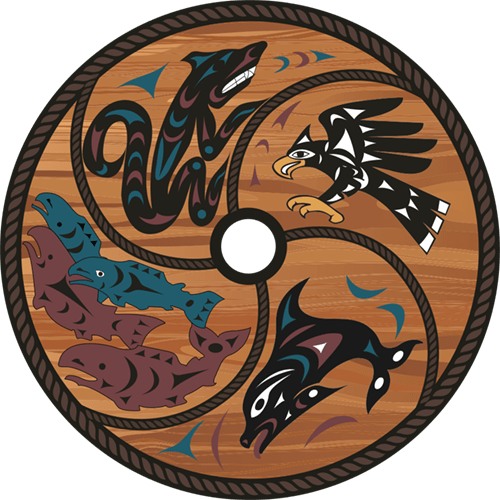W̱SÁNEĆ Leadership Council releases 5-year strategic plan
On May 7, 2018, the leadership of Tsartlip, Tseycum, and Tsawout* came together to form the W̱SÁNEĆ Leadership Council Society (WLC) in order to strengthen their position on shared issues within W̱SÁNEĆ territory. On July 14th, 2022 WLC further reinforced the collective vision and intentions through the creation of a 5-year strategic plan.

Prior to the formation of the WLC, multiple layers of government and corporations benefited from the artificial separation of W̱SÁNEĆ people through the reserve system. Accordingly, the resulting infringements on W̱SÁNEĆ territory and breaches of Douglas Treaty Rights were more difficult to resist and remedy. As such, W̱SÁNEĆ leadership decided to work together on shared areas of concern, specifically in discussions with the various public and private bodies operating within W̱SÁNEĆ territory.
Over the last four years, the WLC has achieved numerous accomplishments that benefit W̱SÁNEĆ people, the organization has grown and with it, its impact. In order to continue its efficacy, leadership acknowledged the need for a detailed long-term plan to guide further work and ensure that all WLC leadership, staff, and members were on the same page and share a clear vision.
As such, the WLC decided it was time to draft a formal 5-year plan to guide the organization’s activities going forward. Guided by collaboration from elders, the Board of Directors (BOD), and staff over many months, the WLC is pleased to announce the completion of a 5-year strategic plan outlining the organization’s major objectives and intentions for growth in the future.
Gord Elliott, Director of Operations for the WLC, shares, “The 5-year strategic plan will provide the Board of Directors and staff with a collective vision and a road map for attaining our goals. It will require a lot of work to implement the plan, but the political will, determination, and passion are there to ensure that the hard work will take place.”
The strategic plan has four main components:
RECONCILIATION & NATION-TO-NATION RELATIONSHIP
The focus of the first part of the strategic plan is on reconciliation & building the Nation-To-Nation Relationship. This section outlines the WLC’s plans to continue to revitalize and implement W̱SÁNEĆ rights outlined in the Douglas Treaties which are the foundation of the Canada to W̱SÁNEĆ (Nation to Nation) relationship.
This initiative will begin with ongoing meetings with W̱SÁNEĆ community members to determine the best way to proceed in the implementation of the Douglas Treaties. This open dialogue will empower all W̱SÁNEĆ people to voice their thoughts and concerns on how these Treaties can be utilized to better serve the needs of the community.
In addition to community engagement, another goal is to build awareness among W̱SÁNEĆ people of the Douglas Treaties, the history of how they came to be, the rights that are protected under the Treaties and what they represent for W̱SÁNEĆ people today.
A few possible avenues for awareness are the implementation of a Douglas Treaty Education program, including a digital library, and a Seven Generations Douglas Treaty comic to be made available in schools.
Other initiatives to promote awareness of W̱SÁNEĆ people, history, and culture include street renaming to reflect traditional W̱SÁNEĆ place names and interpretive signage to mark these updates. Additionally, resources on how to deliver territorial land acknowledgments will be provided on the WLC website and the W̱SÁNEĆ Art Protocol Policy will be distributed to the school district. The WLC will also collaborate with researchers and publishers of various institutions like the UBC Press and National Resource Council to produce material that conveys the W̱SÁNEĆ worldview through academic platforms.
OCCUPYING W̱SÁNEĆ JURISDICTION
The second objective outlined in the strategic plan details plans for occupying W̱SÁNEĆ jurisdiction. The WLC will seek co-management agreements with several groups, including BC Parks, the Department of Fisheries and Oceans, Transport Canada, and other bodies currently active in W̱SÁNEĆ Territory. Once achieved, these co-management agreements could be stepping stones to reclaiming full decision-making power for W̱SÁNEĆ people over W̱SÁNEĆ Territory.
Remediation efforts are also indicated in the plan as another method of strengthening W̱SÁNEĆ occupation. These efforts include a carbon sequestration plan, control burns, ivy removal, and creek restoration, among others. These activities will help revitalize traditional W̱SÁNEĆ ways of managing the environment, and further progress the WLC’s mandate.
In the interests of the advancing well-being of W̱SÁNEĆ people and culture, and repairing the damage done by colonialism, the WLC also will be seeking economic compensation from many organizations and various parts of government that operate on W̱SÁNEĆ territory. For example, Transport Canada, Victoria Airport Authority, and BC Hydro have all had significant impacts on W̱SÁNEĆ lands and waters. Therefore the WLC is looking to form relationship agreements to mitigate their effects on the self-determination, recognition, and respect of W̱SÁNEĆ people.
KEEPING OUR CIRCLE STRONG
The third, yet potentially most critical, section of the strategic plan is “Keeping Our Circle Strong.” To maintain the trust of the community and integrity of the community’s wishes throughout the process of carrying out the strategic plan, the WLC will continue to keep W̱SÁNEĆ people and community members actively engaged through implementing W̱SÁNEĆ natural laws and strengthening traditional skills.
The development of a land and water-based curriculum to further these ends will help community members become more engaged in traditional knowledge and culture which fosters healing and strengthen these essential community bonds.
For the WLC to be successful, a shared understanding of the organization is essential. The WLC plans to hold WLC 101 sessions and regular update meetings to keep W̱SÁNEĆ community members up to date and informed. In addition, quarterly printed newsletters, social media, and an annual report will all be available as additional sources of up to date and consistently communicated information for members.
GOVERNANCE AND CAPACITY
The final item on the strategic plan is “Governance and Capacity.” One of the primary elements of this section is to incorporate an enhanced level of culture and language into activities. An increased connection to language, tradition, and the W̱SÁNEĆ worldview will strengthen all areas of the WLC’s work going forward.
To reflect the ongoing growth of the organization, the WLC will create new committees, job titles, and staff positions, further increasing connection to community. Finally, each Chief and Council, on behalf of their membership has contributed to, reviewed, and approved the strategic plan.
While the strategic plan is very much a forward-looking document, it will serve as a continuation of many initiatives that have been successfully underway for years. For example, the WLC has already made remediation efforts through several programs such as clam garden restoration, the hunting program known as Fur to Forest, and Growing Together, the WLC’s program for environmental restoration. These initiatives serve as successful demonstrations of the efficacy of the W̱SÁNEĆ Leadership Council’s work to date.
The WLC’s mandate is to promote respect for W̱SÁNEĆ culture, traditional practices, and language, all in the interest of the W̱SÁNEĆ First Nations. The W̱SÁNEĆ Leadership Council, guided by the strategic plan, will continue to move forward in uniting W̱SÁNEĆ nation in self-determination and reconciliation.
Click here to download the strategic plan or here to download the summary document.
*at the time of signing Tsawout was still an active member of the WLC. Since that time, the WLC is working with Tsawout in a less formal capacity to find common ground and work together.










